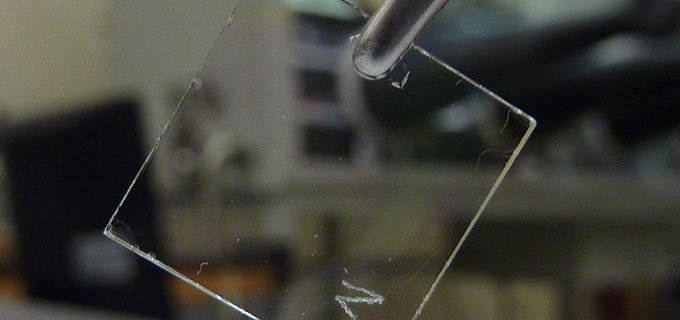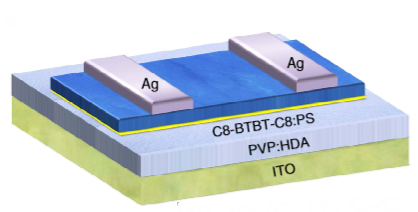World’s fastest organic transistor could lead to low-cost transparent electronics
January 10, 2014

Transparent
transistors on this postage-stamp-size glass have speed characteristics
rivaling some forms of more-expensive silicon transistors. A new
process made this world-record-setting organic transistor, paving the
way for a new generation of cheap, transparent electronic devices.
(Credit: Jinsong Huang and Yongbo Yuan)
For years, engineers have been trying to use inexpensive, carbon-rich molecules and plastics to create organic semiconductors capable of performing electronic operations at something approaching the speed of costlier technologies based on silicon. (The term “organic” has been extended to include synthetic substances based on carbons and includes plastics.)
Typically, researchers drop a special solution, containing carbon-rich molecules and a complementary plastic, onto a spinning platter — in this case, one made of glass. The spinning action deposits a thin coating of the materials over the platter.
Faster organic transistors with new process
[+]
In their Nature Communications paper, the collaborators
describe two important changes to this basic process: they spun the
platter faster and only coated a tiny postage-stamp-size portion of the
spinning surface.
Off-center spin-coating process for creating organic material for transparent transistors (credit: Yongbo Yuan et al./Nature Communications)
These innovations had the effect of depositing a denser concentration of the organic molecules into a more regular alignment. The result was a great improvement in carrier mobility, which measures how quickly electrical charges travel through the transistor.
The researchers called this improved method “off-center spin coating.” The process remains experimental, and the engineers cannot yet precisely control the alignment of organic materials in their transistors or achieve uniform carrier mobility.
[+]
However, even at this stage, off-center spin coating produced
transistors with a range of speeds much faster than those of previous
organic semiconductors and comparable to the performance of the
polysilicon materials used in today’s high-end electronics.
Faster organic thin-film transistor fabricated on transparent indium tin oxide-coated glass (credit: Yongbo Yuan et al./Nature Communications)
Further improvements to this experimental process could lead to the development of inexpensive, high-performance electronics built on transparent substrates such as glass and, eventually, clear and flexible plastics. Already, the researchers have shown that they can create high-performance organic electronics that are 90 percent transparent to the naked eye.
The work was funded by the U.S. Defense Advanced Research Projects Agency (DARPA), the Air Force Office of Scientific Research, and the National Science Foundation.
Abstract of Nature Communications paper
Organic semiconductors with higher carrier mobility and better transparency have been actively pursued for numerous applications, such as flat-panel display backplane and sensor arrays. The carrier mobility is an important figure of merit and is sensitively influenced by the crystallinity and the molecular arrangement in a crystal lattice. Here we describe the growth of a highly aligned meta-stable structure of 2,7-dioctyl[1]benzothieno[3,2-b][1]benzothiophene (C8-BTBT) from a blended solution of C8-BTBT and polystyrene by using a novel off-centre spin-coating method. Combined with a vertical phase separation of the blend, the highly aligned, meta-stable C8-BTBT films provide a significantly increased thin film transistor hole mobility up to 43 cm2 Vs−1 (25 cm2 Vs−1 on average), which is the highest value reported to date for all organic molecules. The resulting transistors show high transparency of >90% over the visible spectrum, indicating their potential for transparent, high-performance organic electronics.
(¯`*• Global Source and/or more resources at http://goo.gl/zvSV7 │ www.Future-Observatory.blogspot.com and on LinkeIn Group's "Becoming Aware of the Futures" at http://goo.gl/8qKBbK │ @SciCzar │ Point of Contact: www.linkedin.com/in/AndresAgostini
 Washington
Washington